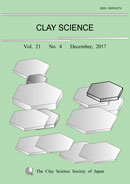
- Issue 4 Pages 63-
- Issue 3 Pages 41-
- Issue 2 Pages 21-
- Issue 1 Pages 1-
- |<
- <
- 1
- >
- >|
-
Ayumi Matsuda, Xinning Wang, Yuki Mori, Shin-Ichiro Wada2017Volume 21Issue 4 Pages 63-70
Published: December 25, 2017
Released on J-STAGE: January 19, 2018
JOURNAL FREE ACCESSAssessing the rate of release of potassium (K) from soils and minerals is important in soil management as well as in understanding weathering processes of minerals including micas and feldspars. We here propose a method to measure K release and transport rates in soils and minerals. The method uses an H-exchanged cryptomelane that is highly specific to K+ as an adsorbent. A small amount of sample wetted by water or aqueous solution is brought to contact with the adsorbent across two sheets of membrane filter and the amount of K accumulated in the adsorbent is measured after digestion. Test application of this method to four soil samples showed that an amount of K equivalent to exchangeable K migrated to the adsorbent within 24 h and further K release continued in 360 h or more at a rate depending on the type of soil. We also present an improved method for the preparation of the adsorbent.
View full abstractDownload PDF (593K) -
Motoharu Kawano, Mako Miyashita2017Volume 21Issue 4 Pages 71-78
Published: December 25, 2017
Released on J-STAGE: January 19, 2018
JOURNAL FREE ACCESSPhosphate and sulfate are abundant inorganic anions in natural aqueous environments. To evaluate the effect of these inorganic anions on the precipitation rate and polymorphism of calcium carbonate (CaCO3) minerals, precipitation experiments were performed in the systems containing phosphate or sulfate by the batch method using 100 mL solution at 25°C. Each solution contained 5.0 mM Ca2+ and Mg2+, and 20.0 mM HCO3− ions with 0.00, 0.01, 0.05, 0.1, 0.5, and 1.0 mM of phosphate or sulfate. Results indicated that phosphate tended to decrease the precipitation rate of CaCO3 minerals and favored the formation of aragonite instead of calcite as a predominant polymorph with increasing the phosphate concentrations. Whereas, it was found that sulfate exhibited no significant effect on both precipitation rate and polymorphism of CaCO3 minerals in solutions with sulfate concentrations up to 5.0 mM.
View full abstractDownload PDF (1148K)
- |<
- <
- 1
- >
- >|